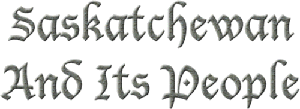EVOLUTION OF TOWNS AND VILLAGES.
TRAILS, ROADS, BRIDGES AND FORDS.
When the Legislative Assembly came into existence it could hardly be
said that there was a "road" in the country. We were dependent on trails.
The road allowances were only used so far as was convenient. The trails
wound along, avoiding sloughs and bluffs, and making more or less ser-
pentine tracks over the free range. The alternate section plan of one sec-
tion for homesteading and the next for C. P. R. (or for Hudson's Bay Co.
or school lands) was certainly a great help in those days. There was al-
ways a cry more or less from the politicians for close settlement so as to
help taxation, but the quarter section farmer had only to think of the
sort of a living he would make penned in on 160 acres for his grain, hay,
pasture and wood, to be thankful for the vacant lands. There were the
old Hudson's Bay and Indian trails made by the Red River carts drawn
by single animals. These consisted of three ruts two made by the wheels,
and one in the middle by the pony or ox. They are now obliterated. To
make a new trail over the prairie was easy. A single wagon track, made
in one journey over the green grass would be visible all the season, and
could be easily followed. The grass trails, with the light traffic over them
took years sometimes before they became black trails. If the ruts were
worn down so that the grass was killed there would still be the green grass
in the middle.
The prairie makes a natural road bed. On a certain class of soil, with
natural drainage there would be sections of trail so smooth and hard that
the expenditure of a million dollars a mile could not have improved them.
When settlement began to grow thick, and traffic was forced into the road
allowances, there was no way of avoiding the low places. They were
simply graded with clay, and in wet weather were bad places to cross. As
there was no real system for years about the road making, these com-
pulsory trails often made in places, very poor travelling. Another trou-
blesome thing in this growing time was that one would find old trails
fenced across, and if this happened at night you might have considerable
trouble with the new way round which you didn't know.
The settler who had to cross one of our deep valleys to get to market
was under a heavy handicap in those days. The trail followed some
ravine which would be graded in places in its narrow bottom. In a heavy
storm these ravines would become water courses, and there would be small
washout'~~ here and there all the way down. Then the idea took hold to
plough along the side of the ravine, so that the road was nIcked into the
side hill and so things got better and better; and travelling in company
with a load so that one could double up in hilly or bad places became less
and less a necessity.
The fords were a positive danger, and many lives were lost. There
was a great deal of recklessness. Men would take a chance when the
water was up, and sometimes it went against them. Thrilling stories
could be told of disasters at the fords. Three or four Mounted Police were
once drowned.
One rather peculiar instance may, be recorded. It was told the writer
by an ex-sergeant of the Mounted Police. At that time there were Indian
scouts, in uniform, attached to the Mounted Police in the west. One of
these scouts was sent from one post to another. He had to ford the Belly
River. The horse came back minus its rider. My informant, then a
constable, was sent on the same errand with the same horse. At the ford
he found the river in flood, but nothing to hurt. As it was here the scout
had been drowned the constable was very watchful, as he could not con-
ceive of how he came to grief. He walked the horse into the river. When
he struck swimming water the horse threw itself instantaneously on its
side. But for his watchfulness he might have been unseated, dragged
along by the stirrup and drowned as the scout undoubtedly was. The
sergeant told me that occasionally you find a horse that swims on its side,
but they are rare, and up to then he had never heard of a case.
Bibliography follows:

